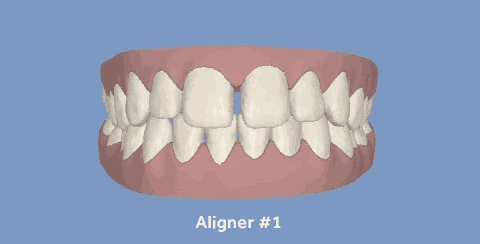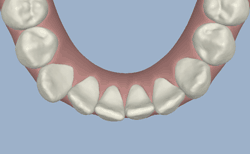

Ceramic braces are made of clear materials and are therefore less visible on your teeth than metal braces. For this reason, ceramic braces are used mainly on older teenagers and adult patients who have cosmetic concerns. While they are visually less prominent, they do require more attention to oral hygiene as ceramic braces are larger and are more brittle than their metal counterparts. For these reasons, ceramic braces tend to be used more on upper front teeth than on lower teeth.

Traditional metal braces are the most common type of braces and are more comfortable today than ever before. Made of high-grade stainless steel, metal braces straighten your teeth using metal brackets and archwires. With metal braces, you have the option of adding colored elastics (rubber bands) for a more unique and colorful smile.

Invisalign® uses a series of invisible, removable, and comfortable aligners that no one can tell you're wearing. So, you can smile more during treatment as well as after. Invisalign is made with 3D computer imaging technology and has been proven effective. More than 70% of orthodontists in the US and Canada are certified to treat with Invisalign.
Why would I want it:
Not only are the aligners invisible, they are removable, so you can eat and drink what you want while in treatment. Plus, brushing and flossing are no problem. They are also comfortable, with no metal to cause mouth abrasions during treatment. And no metal and wires usually means you spend less time in your doctor's office getting adjustments. Invisalign also allows you to view your own virtual treatment plan when you start so you can see how your straight teeth will look when your treatment is complete.
How does it work:
You wear each set of aligners for about two weeks, removing them only to eat, drink, brush, and floss. As you replace each aligner with the next in the series, your teeth will move — little by little, week by week — until they have straightened to the final position your doctor has prescribed. You'll visit our practice about once every six weeks to ensure that your treatment is progressing as planned. Total treatment time averages 9-15 months and the average number of aligners worn during treatment is between 18 and 30, but both will vary from case to case.
Dr. Fetouh's Research about Invisalign:
Dr. Fetouh completed his research in Invisalign treatment titled, "Comparing the Treatment Outcome of Invisalign to Traditional Braces" which awarded him his Masters Degree in Orthodontics in December 2008 from the Department of Orthodontics at SUNY in Buffalo, New York.
Dr.Fetouh's research is quoted on Wikipedia's page about Invisalign under Scientific Studies.

Wear your retainers full time, until the doctor instructs otherwise. If you do not wear them as instructed by your dentist your teeth will shift, and you will need braces again to correct the movement .
Take your retainers out when eating, and always put retainers in their case! (Most appliances are lost in school lunch rooms or restaurants.)
Clean retainers thoroughly once a day with a toothbrush and toothpaste. Use warm but not hot water. Brushing retainers removes the plaque, and eliminates odors. Efferdent® or other orthodontic appliance cleaners can be used but do not take the place of brushing. When retainers are not in your mouth they should ALWAYS be in a retainer case. Pets love to chew on them!
Initially, you may find it difficult to speak. Practice speaking, reading, or singing out loud to get used to them faster.
Retainers are breakable, so treat them with care. If retainers are lost or broken call us immediately.
If you have any questions or concerns about your retainers, or if your retainers need adjusting, call us. Do not try to adjust them yourself.
Always bring your retainers to your appointments.
Retainer replacements are expensive, but with proper care they will last for years!
Remove retainers when swimming.
Keep retainers away from hot water, hot car dashboards, pockets, the washing machine, and napkins.

Lorem ipsum dolor sit amet, consectetur adipisicing elit. Autem laudantium in adipisci ipsa optio quas id excepturi non, eos cupiditate, necessitatibus sapiente illo error. Vero adipisci quidem aut itaque labore.

Early treatment (also known as Phase-One) typically begins around age eight or nine (Phase-Two will begin around age 11 or older). The goal of early treatment is to correct the growth of the jaw and certain bite problems, such as underbite. Early treatment also helps to make room for permanent teeth to come in properly, lessening the chance of extractions in the future.
Early or late loss of baby teeth (your child should typically start losing teeth around age five, and will have all their permanent teeth in around age 13)
Difficulty chewing and/or biting
Mouth breathing
Your child continues sucking their thumb after age five
Speech impediments
Protruding teeth (the top teeth and the bottom teeth extend away from each other)
Teeth that don't come together in a normal manner or even at all
Shifting of the jaw when your child opens or closes their mouth (crossbites)
Crowded front teeth around age 7 or 8
Orthodontic problems such as crowding of the teeth, too much space between the teeth, jaw growth problems, protruding teeth, and bad bites can be inherited or caused by injury to the mouth, early or late loss of baby teeth, or thumb sucking habits.
Most children have lost all their baby teeth by age 13 and by the end of their teen years the jaw bones will harden and no longer continue to grow. Orthodontic procedures for adults often take more time and can involve tooth extraction and the possibility of oral surgery. As a child, receiving early orthodontic treatment can help prevent the need for orthodontics as an adult, leaving little to no chance of extraction or surgery in the future.
If your child is between the ages of seven and eight and shows signs of needing orthodontic care, or if you have been directed by your family dentist to visit the orthodontist, please contact our practice and schedule an appointment. Our team will provide your child with an initial exam, and discuss with you the best steps to take toward caring for your child's smile.